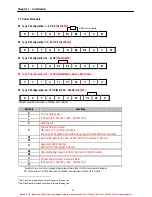
Chapter 1 – Installation
17
1.7.5
Wiring Power Terminals
n
Wiring Precautions
l
The internal circuits of the inverter will be damaged if the incoming power is connected and applied to output
terminals (U, V, W).
l
Use ring terminals with insulated caps when wiring the input power and motor wiring.
l
Do not leave wire fragments inside the inverter. Wire fragments can cause faults, breakdowns, and malfunctions.
l
For input and output, use wires with sufficient size to ensure voltage drop of less than 2%.
l
Motor torque may drop of operating at low frequencies and a long wire run between inverter and motor.
l
When more than one motor is connected to one inverter, total wire length should be less than 500m (1,640ft). Do
not use a 3-wire cable for long distances. Due to increased leakage capacitance between wires, over-current
protective feature may operate or equipment connected to the output side may malfunction.
l
Connect only recommended braking resistor between the B1 and B2 terminals.
Never short B1 and B2
terminals. Shorting terminals may cause internal damage to inverter.
l
The main circuit of the inverter contains high frequency noise, and can hinder communication equipment near the
inverter. To reduce noise, install line noise filters on the input side of the inverter.
l
Do not use power factor capacitor, surge killers, or RFI filters on the output side of the inverter. Doing so may
damage these components.
l
Always check whether the LCD and the charge lamp for the power terminal are OFF before wiring terminals. The
charge capacitor may hold high-voltage even after the power is disconnected. Use caution to prevent the
possibility of personal injury.
n
Grounding
l
The inverter is a high switching device, and leakage current may flow. Ground the inverter to avoid electrical shock.
Use caution to prevent the possibility of personal injury.
l
Connect only to the dedicated ground terminal of the inverter. Do not use the case or the chassis screw for
grounding.
l
The protective earth conductor must be the first one in being connected and the last one in being disconnected.
l
As a minimum, grounding wire should meet the specifications listed below. Grounding wire should be as short as
possible and should be connected to the ground point as near as possible to the inverter.
Grounding wire Sizes, AWG (mm
²
)
Inverter Capacity
200V Class
400VClass
Below 5 HP
12 (3.5)
14 (2)
7.5 ~ 10 HP
10 (5.5)
12 (3.5)
15 ~ 20 HP
6 (14)
8 (8)
25 ~ 30 HP
4 (22)
6 (14)
40 ~ 50 HP
4 (22)
6 (14)
60 ~ 100 HP
2 (38)
4 (22)
WARNING
Normal stray capacitance between the inverter chassis and the power devices inside the
inverter and AC line can provide a high impedance shock hazard. Do not apply power to the
inverter if the inverter frame (Power terminal G) is not grounded.
Morek IT OÜ, Rauna 24, 76506 Saue Harjumaa, Estonia. www.morek.eu Tel. +372 604 1423 Fax +372 604 1447 [email protected]
















































